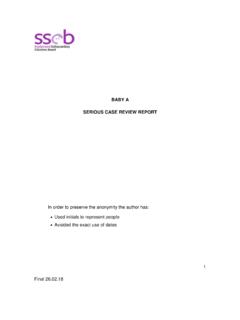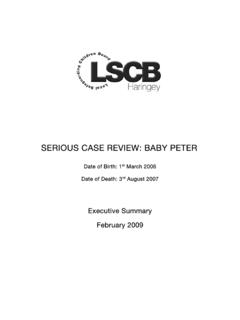Transcription of RESEARCH REPORT 464 - Health and Safety Executive
1 HSE Health & Safety Executive Identifying and evaluating the social and psychological impact of workplace accidents and ill- Health incidents on employees Prepared by Human Reliability Associates Ltd for the Health and Safety Executive 2006 RESEARCH REPORT 464 HSE Health & Safety Executive Identifying and evaluating the social and psychological impact of workplace accidents and ill- Health incidents on employees Heather Cormack Steve Cross Claire Whittington Human Reliability Associates Ltd 1 School House Higher Lane Dalton Wigan WN8 7RP This RESEARCH , and the literature review that preceded it, was commissioned by HSE. The review confirmed that there are few studies that have explicitly examined the impact of serious workplace-related injury and ill Health on individuals, their families and their immediate social network.
2 The study reported here examines the nature and extent of this impact in two specific work sectors: the construction sector and the healthcare sector. These sectors were pre-selected by HSE as representing two priority areas. The RESEARCH involved three complementary strands of work: short telephone interviews with a sample of employees within the relevant sectors who had experienced a serious workplace accident or suffered from a reportable illness, personal home interviews with a limited subset of the more serious cases and their family members, and lastly, further follow-up interviews with a subset of cases who took part in the home interview survey. The study clearly demonstrates that serious work-related accidents and illness can have a widespread impact on individuals and their families.
3 Many will find that their working life is significantly affected: they may be unable to return to work, need a change of job or role to accommodate new restrictions or be conscious that they now approach their work with a level of caution and deliberation not previously in evidence; many will also experience longer-term physical problems. There are also immediate and longer-term economic consequences, both in terms of loss of income (most evident in the construction sector) and the need for extra expenditure associated with the accident or illness. The results of this study also suggest that many individuals (regardless of sector) assign responsibility for both accidents and illness to their employer and will seek redress through financial compensation.
4 This REPORT and the work it describes were funded by the Health and Safety Executive (HSE). Its contents, including any opinions and/or conclusions expressed, are those of the authors alone and do not necessarily reflect HSE policy. HSE BOOKS Crown copyright 2006 First published 2006 All rights reserved. No part of this publication may be reproduced, stored in a retrieval system, or transmitted in any form or by any means (electronic, mechanical, photocopying, recording or otherwise) without the prior written permission of the copyright owner. Applications for reproduction should be made in writing to: Licensing Division, Her Majesty's Stationery Office, St Clements House, 2-16 Colegate, Norwich NR3 1BQ or by e-mail to ii CONTENTS Executive 1 1 Management 2 2 2 Methodology.
5 2 Key 3 2 8 Background and aims .. 8 Main RESEARCH methods ..10 Ethical Structure of the 3 Survey methodology sample 13 Sample 13 Methods of approach to potential participants and selection of 16 Details of final sample structure .. 21 4 Survey methodology issues 27 Background literature Overview of key issues covered in the Structure and content of interview schedules ..30 5 Results of the telephone 33 33 The Telephone Survey sample ..34 Interview structure ..36 Construction Sector Results .. 38 Healthcare Sector 6 Case 61 Introduction to the case summaries and associated overviews.. 61 Construction accident group - overview.
6 63 Construction accident group - case studies ..81 Construction illness group - 122 Construction illness group case 141 Healthcare accidents group - 181 Healthcare accident group - case studies .. 198 Healthcare illness group - 238 Healthcare illness group case 258 7 299 General structure of the 299 iii Methodological 299 Vocational consequences .. 302 Economic 307 Social 310 Behavioural 314 Psychological 316 Impact on family 319 Comparison with other 321 8 Implications for practice and areas for 323 Interfacing with those suffering from serious accidents or chronic 324 Managing long-term sickness absence and return to 327 9 333 10 References.
7 362 iv Executive SUMMARY This RESEARCH , and the literature review that preceded it, was commissioned by HSE. The review confirmed that there are few studies that have explicitly examined the impact of serious workplace-related injury and ill Health on individuals, their families and their immediate social network. The study reported here examines the nature and extent of this impact in two specific work sectors: the construction sector and the healthcare sector. These sectors were pre-selected by HSE as representing two priority areas. The RESEARCH involved three complementary strands of work: short telephone interviews with a sample of employees within the relevant sectors who had experienced a serious workplace accident or suffered from a reportable illness, personal home interviews with a limited subset of the more serious cases and their family members, and lastly, further follow-up interviews with a subset of cases who took part in the home interview survey.
8 The study clearly demonstrates that serious work-related accidents and illness can have a widespread impact on individuals and their families. Many will find that their working life is significantly affected: they may be unable to return to work, need a change of job or role to accommodate new restrictions or be conscious that they now approach their work with a level of caution and deliberation not previously in evidence; many will also experience longer-term physical problems. There are also immediate and longer-term economic consequences, both in terms of loss of income (most evident in the construction sector) and the need for extra expenditure associated with the accident or illness.
9 The results of this study also suggest that many individuals (regardless of sector) assign responsibility for both accidents and illness to their employer and will seek redress through financial compensation. Following an accident, day-to-day activities and family life are often seriously affected, in many cases for lengthy periods of time. Chronic conditions, such as Hand Arm Vibration Syndrome (HAVS) or latex allergy, were also shown to have a significant impact on the quality of life, often in ways that intrude on more personal and intimate levels of daily and family life. Behaviour is often affected with many individuals reporting changes such as disturbed sleep, adverse changes in temperament and a decrease in sexual activity.
10 Whilst the study has shown that many family members, and particularly partners, are generous and often unwavering in their support, these effects can also impact on others, adversely affecting the behaviour of family members, including children. Although some individuals and family members reported a strengthening of relationships, others felt their relationships had suffered. The latter was more prevalent in the construction sector, where restricted mobility led to feelings of frustration and boredom. Lastly, the study provides strong evidence that there may be serious and long-standing psychological consequences of both workplace accidents and illness.

















